Pioneer has become a central format in the Magic: The Gathering competitive scene, especially with the rise of Regional Championships. Amidst the diverse strategies vying for dominance, one deck has consistently proven its mettle and remained a top-tier contender: Mono Green Devotion. Since last summer, this powerhouse has consistently ranked among the best decks in Pioneer, a testament to its resilience and strategic depth. If you were piloting top-tier decks, particularly from lists highlighted in articles around June, you’d likely have found yourself consistently well-positioned within the format.
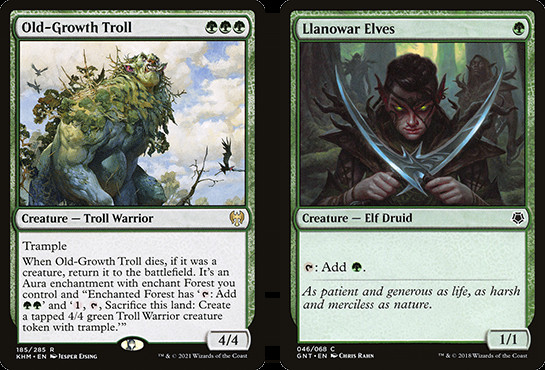 Alt text: Old-Growth Troll and Llanowar Elves, key creatures for mana ramp and devotion in Mono Green Pioneer.
Alt text: Old-Growth Troll and Llanowar Elves, key creatures for mana ramp and devotion in Mono Green Pioneer.
Despite its proven track record, Mono Green Devotion often faces unwarranted skepticism. Players concoct various reasons to avoid it, but as a deck firmly entrenched in Pioneer’s top echelons, it’s time to address these misconceptions head-on. We’ll dismantle these excuses and demonstrate why you should seriously consider embracing the power of Mono Green. Furthermore, this guide will equip you with the knowledge to pilot this deck effectively, ensuring you’re ready to conquer your next Pioneer event.
Debunking the “Dumb Ramp Deck” Myth
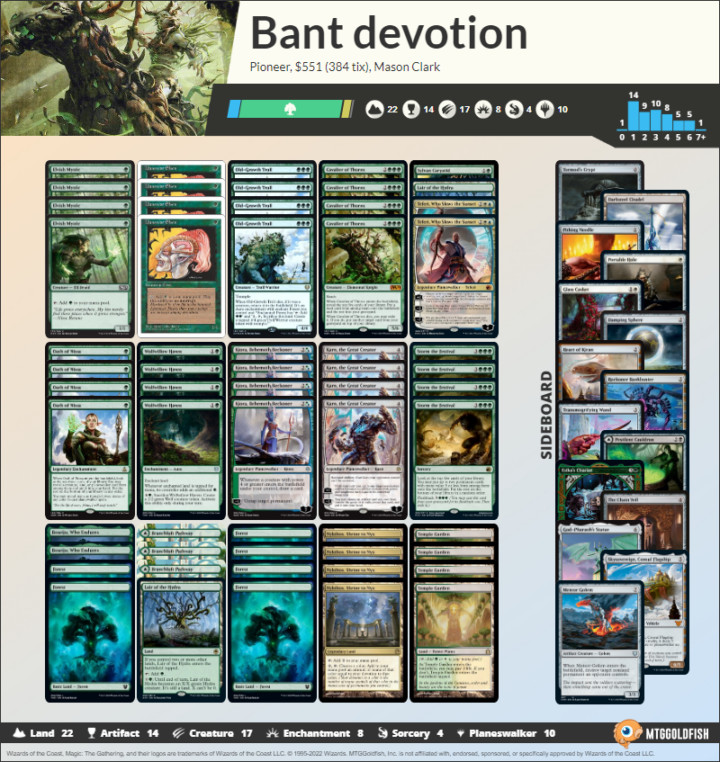 Alt text: Mono Green Devotion Pioneer decklist image, illustrating the card composition for mana acceleration and powerful payoffs.
Alt text: Mono Green Devotion Pioneer decklist image, illustrating the card composition for mana acceleration and powerful payoffs.
It’s true, at its core, Mono Green Devotion is a ramp strategy aiming to deploy impactful, game-altering threats ahead of schedule. However, dismissing it as a “dumb” deck that requires minimal skill is a profound mischaracterization. This perspective overlooks the intricate decision-making and nuanced gameplay that are crucial for mastering Mono Green Devotion.
One of the most skill-intensive aspects of playing this deck lies in mulligan decisions. Magic is heavily influenced by opening hands, and Mono Green Devotion is no exception. The deck is capable of explosive starts, and therefore, keeping a mediocre seven-card hand lacking early acceleration or a clear game plan is often detrimental. Distinguishing between a hand that is “just fine” and one that is truly capable of executing the deck’s strategy is a critical skill. It requires discipline and a deep understanding of the deck’s potential and the matchup at hand.
Beyond mulligans, maximizing your “outs” and playing the percentages are paramount. Mono Green Devotion operates more like a combo-midrange hybrid than a straightforward ramp deck. It leverages mana acceleration not just to cast big creatures, but to assemble a powerful engine fueled by devotion to green mana symbols, culminating in game-winning combinations. This requires careful planning, resource management, and an understanding of when to pivot between aggressive strategies and combo lines.
Ultimately, it’s essential to question the premise of the “dumb ramp deck” criticism. Even if it were a simple strategy (which it isn’t), does that diminish its effectiveness? Does playing a more intellectually demanding deck inherently translate to more wins? Match points are awarded for victories, not for the perceived complexity of your chosen strategy. If Mono Green Devotion is positioned as a top contender in the current metagame, and your primary goal is to win, then preconceived notions about deck complexity should be set aside in favor of strategic effectiveness.
Overcoming the “Too Hard” Combo Misconception
The combo element within Mono Green Devotion might initially seem daunting when described abstractly. However, witnessing it unfold in a game clarifies its mechanics considerably. Once you see the pieces in action, the synergy becomes much more intuitive. For players who find the standard combo variant overly intricate, simplified versions exist, often incorporating Teferi, Who Slows the Sunset to streamline the process. Starting with these Teferi-centric builds can be an excellent way to grasp the core combo principles before delving into more complex iterations.
Let’s illustrate a simplified combo sequence using Teferi and The Chain Veil:
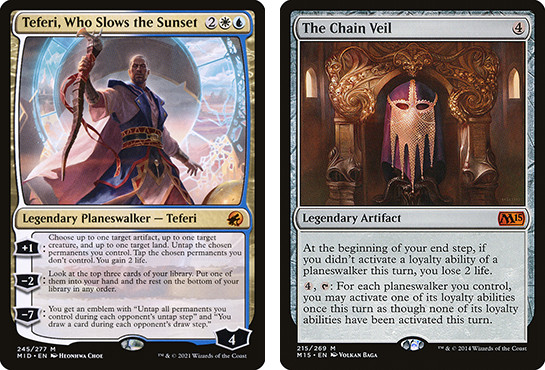 Alt text: Teferi, Who Slows the Sunset, and The Chain Veil, combo pieces for generating infinite mana and life in Mono Green Devotion.
Alt text: Teferi, Who Slows the Sunset, and The Chain Veil, combo pieces for generating infinite mana and life in Mono Green Devotion.
Scenario: You control Teferi, Who Slows the Sunset, The Chain Veil, and have at least six devotion to green, enabling significant mana production from Nykthos, Shrine to Nyx.
- Activate Nykthos: Generate mana equal to your devotion (six or more).
- Activate The Chain Veil: Spend four mana to activate The Chain Veil, granting each planeswalker you control an additional activation this turn. You’re left with at least two mana floating.
- Activate Teferi: Use Teferi’s -3 ability to untap Nykthos and The Chain Veil.
- Repeat: You now have access to Nykthos and another Teferi activation due to The Chain Veil. Repeat steps 1-3.
This loop generates infinite Teferi activations, leading to infinite life gain as Teferi’s +1 ability grants you 2 life each activation. With infinite life, your opponent’s path to victory becomes virtually nonexistent. Furthermore, if you have seven or more devotion, this loop also generates infinite mana, opening up even more devastating possibilities. We’ll delve into the deeper combo intricacies later, but even this basic understanding demonstrates the combo’s accessibility and power.
It’s also crucial to remember that Mono Green Devotion is not solely reliant on complex combos. A significant portion of games are won through straightforward aggression. Cards like Old-Growth Troll and Cavalier of Thorns are formidable threats in Pioneer, capable of applying immense pressure and closing out games through combat damage.
Mastering the Mulligan Strategy
Effective mulliganing is paramount to success with Mono Green Devotion. Your ideal opening hand should contain early mana acceleration, such as mana dorks (e.g., Llanowar Elves, Elvish Mystic) and ideally, a payoff card – a card that benefits from the mana ramp. A general rule of thumb is that if your seven-card hand lacks a turn-one or turn-two acceleration play, you are often better off taking a mulligan, regardless of the matchup.
The primary exception to this rule is against Rakdos Midrange. In this specific matchup, prioritizing lands over acceleration is sometimes correct. Rakdos Midrange excels at efficient removal, and an abundance of lands can dilute the effectiveness of their removal spells, ensuring you consistently have resources to deploy threats. However, outside of this niche scenario, aggressively seeking a hand with a turn-one mana elf is a sound strategy, and going down to five cards to achieve this is often a worthwhile gamble.
A common dilemma players face is whether to keep hands that are heavily skewed towards ramp, lacking immediate payoff cards. Whether you’re on the play or draw, the answer is generally yes. While these hands are not perfect, the explosive mana advantage they provide dramatically increases your chances of drawing into powerful payoff cards in subsequent turns. Although there’s a small risk of failing to draw a game-winning threat, the upside of generating vast amounts of mana early outweighs this risk in most situations. Any top-end card you draw with this mana advantage becomes incredibly potent.
It’s easy to overthink these ramp-heavy hands and convince yourself to mulligan, but achieving a perfect seven-card hand is rare. When your hand has the essential ramp components, but is missing that single payoff piece, you must accept this inherent variance of the deck and trust in your draw steps. Don’t be afraid to mulligan aggressively with Mono Green Devotion. While it is a critical mass deck that benefits from card advantage, prioritizing the right tools – mana acceleration – is often more crucial than raw card count.
Spell Sequencing for Maximum Mana and Advantage
Optimizing spell sequencing is a critical skill that separates proficient Mono Green Devotion players from novices. The goal is to not only generate the maximum mana possible each turn but also to create the most opportunities to find and deploy the cards you need to advance your game plan.
Wolfwillow Haven exemplifies this principle. When played, it immediately recoups mana if attached to an untapped land, effectively costing only one green mana to cast in many scenarios.
 Alt text: Wolfwillow Haven and Kiora, Behemoth Beckoner, illustrating mana sequencing synergy in Mono Green Devotion.
Alt text: Wolfwillow Haven and Kiora, Behemoth Beckoner, illustrating mana sequencing synergy in Mono Green Devotion.
Consider a scenario where you have four mana available and intend to cast Kiora, Behemoth Beckoner this turn. By playing Wolfwillow Haven on an untapped land before casting Kiora, you ensure that you maintain access to four mana after casting Haven (as it effectively refunds one mana when enchanting an untapped land). Furthermore, this sequence unlocks the potential for Kiora to untap the land enchanted by Wolfwillow Haven, generating even more mana for additional plays within the same turn.
This example, while straightforward, highlights the subtle yet impactful sequencing decisions that arise frequently when piloting Mono Green Devotion. It’s easy to overlook these min-max opportunities, especially when playing on autopilot. In a deck with limited card manipulation, maximizing every incremental mana advantage and strategic play is crucial to compensate for the lack of card selection.
An entire article could be dedicated to sequencing intricacies within Mono Green Devotion. However, the key takeaway is to consciously evaluate your mana and potential plays each turn. Take a moment to consider different sequencing options to ensure you’re extracting the maximum mana possible and efficiently progressing towards your win condition.
Deconstructing the Core Combo: Karn, Kiora, and Cauldron
Earlier, we touched on a simplified combo for infinite life using Teferi and The Chain Veil. Now, let’s dissect the primary combo engine of Mono Green Devotion, which utilizes Karn, the Great Creator, Kiora, Behemoth Beckoner, and Pestilent Cauldron.
Initial Setup: To initiate the combo with minimal resources, you need the following board state:
- Nykthos, Shrine to Nyx in play.
- Karn, the Great Creator in play.
- Kiora, Behemoth Beckoner in play.
- At least 8 devotion to green (including Karn and Kiora themselves).
- A second copy of Karn and Kiora in your graveyard (this simplifies the combo; if not, you’ll need 10 devotion and Heart of Kiran from the sideboard as explained in the original article).
- The Chain Veil and Pestilent Cauldron in your sideboard.
Combo Execution:
- Activate Nykthos: With 8 devotion, Nykthos generates 8 green mana.
- Kiora Untap: Use Kiora’s -1 ability to untap Nykthos.
- Reactivate Nykthos: Tap Nykthos again, adding another 8 mana to your pool, totaling 16 mana.
- Karn Fetch Veil: Activate Karn’s -2 ability to fetch The Chain Veil from your sideboard.
- Cast and Activate Veil: Cast The Chain Veil (costing 4 mana) and activate it for 4 mana. You now have 8 mana remaining and each planeswalker can be activated twice this turn. Importantly, The Chain Veil’s effect applies to future planeswalkers played this turn as well.
- Kiora Untap Nykthos (Again): Use Kiora’s second -1 activation (granted by The Chain Veil) to untap Nykthos again.
- Reactivate Nykthos (Again): Tap Nykthos, generating another 8 mana, totaling 16 mana in your pool.
- Karn Fetch Cauldron: Use Karn’s -2 ability to fetch Pestilent Cauldron from your sideboard.
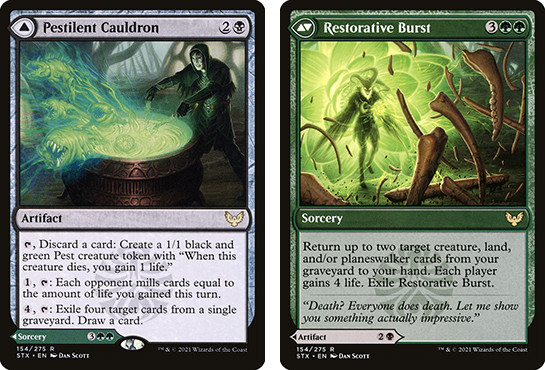 Alt text: Pestilent Cauldron / Restorative Burst, a key sideboard card for both combo initiation and finishing in Mono Green Devotion.
Alt text: Pestilent Cauldron / Restorative Burst, a key sideboard card for both combo initiation and finishing in Mono Green Devotion.
- Cast Restorative Burst: Cast the back side of Pestilent Cauldron, Restorative Burst, targeting the Karn and Kiora that are currently in play (they will die due to the legend rule when you cast new copies in the next steps). Restorative Burst returns Karn and Kiora from your graveyard to your hand. You have approximately 7 mana remaining.
- Recast Kiora: Cast Kiora from hand, costing 3 mana.
- Kiora Untap Nykthos (Repeat): Use Kiora’s -1 to untap Nykthos.
- Reactivate Nykthos (Repeat): Tap Nykthos, generating 8 mana, totaling approximately 12 mana.
- Second Kiora Untap Nykthos: Use Kiora’s second -1 ability (thanks to The Chain Veil) to untap Nykthos again.
- Reactivate Nykthos (Repeat): Tap Nykthos, adding another 8 mana, totaling approximately 18 mana.
- Recast Karn: Cast Karn from hand, costing 4 mana.
You are now in a loop. You have excess mana, a fresh Karn with three loyalty, and you can repeat steps 8-15 indefinitely, generating infinite mana and life through Restorative Burst’s life gain.
Closing out the Game:
To actually win, you’ll transition from infinite life/mana to milling your opponent with Pestilent Cauldron’s front side. Continue the combo loop until you have gained a substantial amount of life (enough to mill your opponent’s deck). Then, instead of fetching Pestilent Cauldron again with Karn, fetch Reckoner Bankbuster.
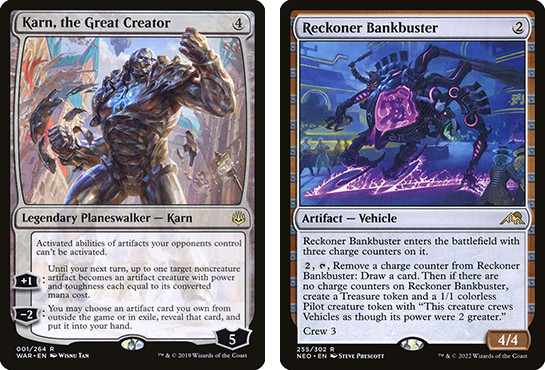 Alt text: Karn, the Great Creator, and Reckoner Bankbuster, showcasing the Karn toolbox and card draw utility in Mono Green Devotion.
Alt text: Karn, the Great Creator, and Reckoner Bankbuster, showcasing the Karn toolbox and card draw utility in Mono Green Devotion.
- Karn Fetch Bankbuster: In the loop, when you have sufficient life, use Karn’s -2 to fetch Reckoner Bankbuster instead of Pestilent Cauldron.
- Cast and Activate Bankbuster: Cast Reckoner Bankbuster and activate its crew ability, then activate its card draw ability multiple times using mana generated in the loop and Kiora to untap it. This generates a Treasure token after the third activation.
- Cast Pestilent Cauldron: Use the Treasure token (and some of your green mana) to cast Pestilent Cauldron.
- Activate Pestilent Cauldron: Activate Pestilent Cauldron, milling your opponent for the amount of life you’ve gained this turn, effectively winning the game.
Quick Sequencing Tips for Advanced Play
- Elf Before Nykthos: If you plan to activate Nykthos and have a mana elf (like Llanowar Elves or Elvish Mystic) in hand, play the elf before activating Nykthos. This is mana-neutral in the short term and increases your devotion count for future Nykthos activations, yielding more mana overall.
- Cavalier of Thorns and Nykthos Timing: When casting Cavalier of Thorns, if you have a Nykthos in play and haven’t seen others, consider activating Nykthos before resolving Cavalier’s trigger. This allows you to use the mana from Nykthos to play another Nykthos if Cavalier’s trigger reveals one, preventing mana waste.
- Storm the Festival Awareness: Similar to Cavalier, be mindful of your board state and available activations before casting Storm the Festival. Ensure you’ve maximized the activations of existing planeswalkers before potentially adding more to the board with Storm the Festival.
- Teferi’s Versatility: Remember Teferi, Who Slows the Sunset‘s +1 ability can tap down opponent’s permanents, including lands to disrupt mana, creatures to clear blockers, or even countermagic sources to resolve key spells.
- Nykthos Mana Calculation Shortcut: A quick way to estimate mana generation from Nykthos when untapping it with Kiora and reactivating is to double your devotion and subtract two (2 * Devotion – 2). This doesn’t account for the initial Nykthos activation mana but provides a rapid estimation for looped activations.
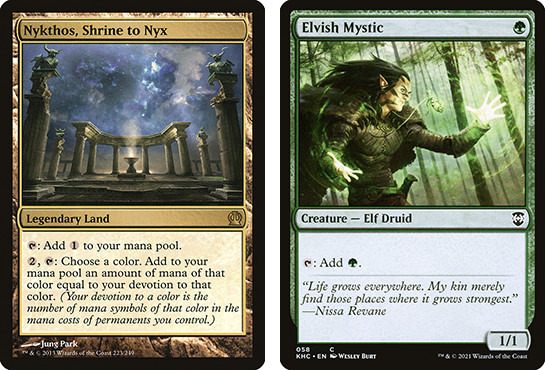 Alt text: Nykthos, Shrine to Nyx, and Elvish Mystic, representing the mana engine and acceleration of Mono Green Devotion Pioneer.
Alt text: Nykthos, Shrine to Nyx, and Elvish Mystic, representing the mana engine and acceleration of Mono Green Devotion Pioneer.
Embrace the Power of Mono Green Devotion
Despite initial perceptions of complexity, Mono Green Devotion is a remarkably powerful and strategically rewarding deck in Pioneer. It consistently proves its place among the format’s elite. If your goal is to maximize your win rate and navigate the Pioneer metagame effectively, dedicating time to learning and playing Mono Green Devotion is a worthwhile investment. You might be surprised at just how dominant and enjoyable this deck can be. Give it a try and experience the raw power of devotion for yourself!
